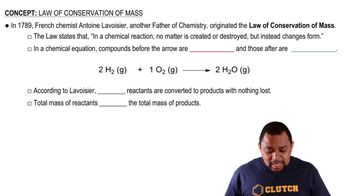Here are the essential concepts you must grasp in order to answer the question correctly.
Molarity
Molarity (M) is a measure of concentration defined as the number of moles of solute per liter of solution. It is commonly used in chemistry to express the concentration of a solution. In this case, the initial concentration of hydrochloric acid is given as 12.0 M, indicating that there are 12 moles of HCl in every liter of solution.
Recommended video:
Dilution
Dilution is the process of reducing the concentration of a solute in a solution, typically by adding more solvent. The dilution equation, M1V1 = M2V2, relates the initial and final molarities (M1 and M2) and volumes (V1 and V2) of the solution. This principle is essential for calculating the new concentration after adding solvent to the original solution.
Recommended video:
Conservation of Mass
The principle of conservation of mass states that mass is neither created nor destroyed in a chemical reaction or physical process. In the context of dilution, this means that the total amount of solute remains constant before and after dilution. Therefore, the number of moles of HCl before dilution must equal the number of moles after dilution, allowing for the calculation of the new concentration.
Recommended video:
Law of Conservation of Mass

 Verified step by step guidance
Verified step by step guidance


